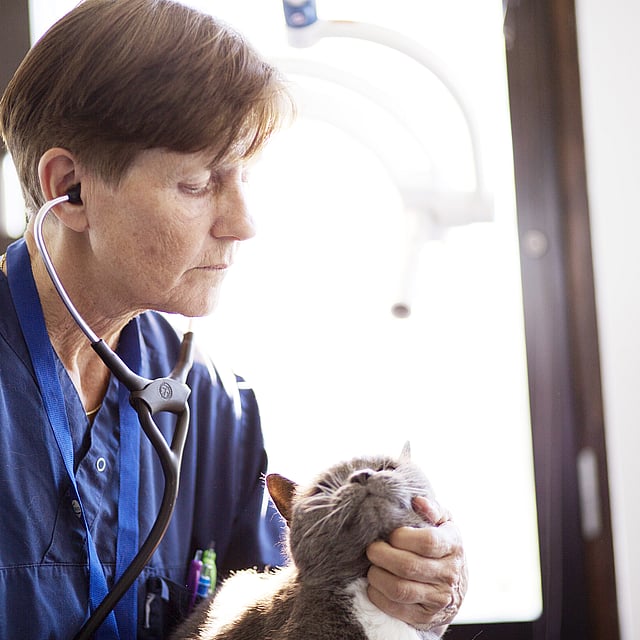Blood tests are part of the routine check-up in elderly animals or risk patients but are also done if diseases are suspected. A blood test can also be necessary to check whether a drug treatment is working or to estimate the further course of a disease.
In emergency situations too, the emergency vet must often take blood, for example to diagnose or rule out poisoning.
How is a blood test done in dogs? #
To test the blood, it must first be drawn through needles and blood tubes.
To draw the blood sample, your pet has to be held in a fixed position. This can appear very rough especially in cats, but it serves to protect the staff and also the cat itself as it should not be injured by the needle.
Mild sedation can sometimes be necessary to obtain the blood safely without stress for the animal.
The site where the blood is to be drawn is usually shaved and then disinfected. However, it is also possible to part the hair with the aid of the disinfectant.
Disinfection and a sterile procedure are important so that no germs get into the needle site that can then cause infection.
The blood flow in the vein is then obstructed briefly to avoid incorrect results.
The needle is then actually inserted into the blood vessel. The blood flows from the needle into one or more sample tubes. Some time and patience are often required until the tube is filled with enough blood. The required volume depends on the minimum filling volume of the tube and the number of parameters to be tested. The tubes must be used in the correct order to avoid contamination with anticoagulants. The citrate tube for coagulation is always filled first in order to obtain correct results.
In what areas of the body is the blood taken? #
That depends on the animal species. Blood is usually taken from the legs. Sometimes the neck vein can be used. In rats, blood can also be drawn from the tail.
Preparation
For many tests, it is advantageous and sometimes even necessary for the animals not to have eaten anything for a certain time. This is the case mainly for blood tests in dogs. In small animals like rabbits and guinea pigs, fasting is harmful so rabbits and rodents must not fast for a blood test. The same applies for birds and reptiles.
Your vet will tell you whether and for how many hours beforehand no food should be given.
Free-roaming cats should be shut into the home before the blood sample is taken as it can otherwise not be ruled out that they have eaten small animals outside.
Important: if you are giving your pet medication as long-term treatment, such as medication for the heart, arthritis or allergy, ask your vet before the blood test. He or she will tell you if the medication should be given at the routine time and whether the blood sample should be taken a certain interval away from giving the tablets.
How is the blood tested?
A few parameters can be measured on site in our own laboratory. Others must be sent to outside laboratories.
The following parameters can be tested:
- Blood count
In this, the cellular components of the blood (blood cells) are measured, e.g., the number of red and white blood corpuscles. The blood count provides information about your pet’s state of health and possible diseases.
- Organ parameters: kidneys, liver, pancreas etc.
These parameters determine how the corresponding organ is functioning. For example, kidney underactivity or thyroid overactivity can be identified. Further tests are often necessary for exact diagnosis.
- Inflammation parameters: CRP (dog)
These laboratory tests show whether inflammation is present in your pet. Changes in these are often used to check the response to a treatment (antibiotic therapy).
- Infectious diseases (direct evidence, antibody evidence, vaccine interaction, maternal antibodies - puppies get these antibodies from the mother, which gives them passive immunity) In this context, the test finds out whether your pet has antibodies against certain infectious diseases.
- Hormones: T4, progesterone (mating time), cortisol
Is the hormone level right? Is the body producing too much or too little of a certain hormone? When is the right mating time? Such information can also be obtained from a blood test in animals. - Medications
With long-term use of medications to treat epilepsy it is important to known the drug level in the blood, phenobarbital or KBr. - Blood clotting
Clotting tests can be used, for instance, to find out whether suspected coumarin poisoning is a possibility. - Electrolytes
Electrolyte levels are measured in certain hormonal diseases but also to monitor infusion therapy in hospitalised patients. - Blood transfusion
The blood group can also be determined when blood tests are done in dogs. Just like humans, dogs have different blood groups that can be compatible with one another or not. If two non-compatible blood groups clash, the blood can agglutinate, which can be fatal for the animal. Determining blood group compatibility is important in blood donation in dogs.
When is a blood test useful in dogs? #
A blood test in dogs is always necessary when an unclear internal medical problem is present or when poisoning is suspected.
A blood test in animals can also be useful to detect or rule out or understand certain diseases.
What does a blood test in dogs and other animal species cost? #
Blood tests are a veterinary service. The costs depend on the test parameters and we are happy to explain these to you.
© AniCura
